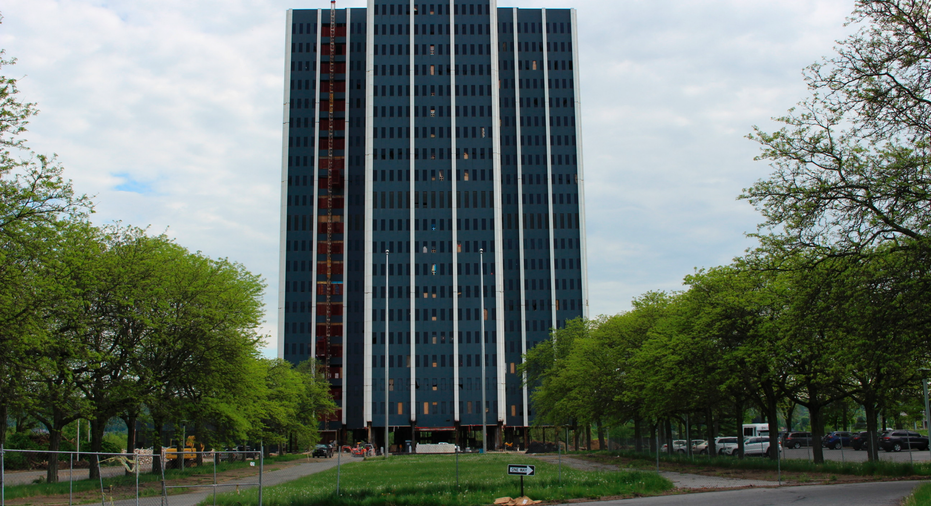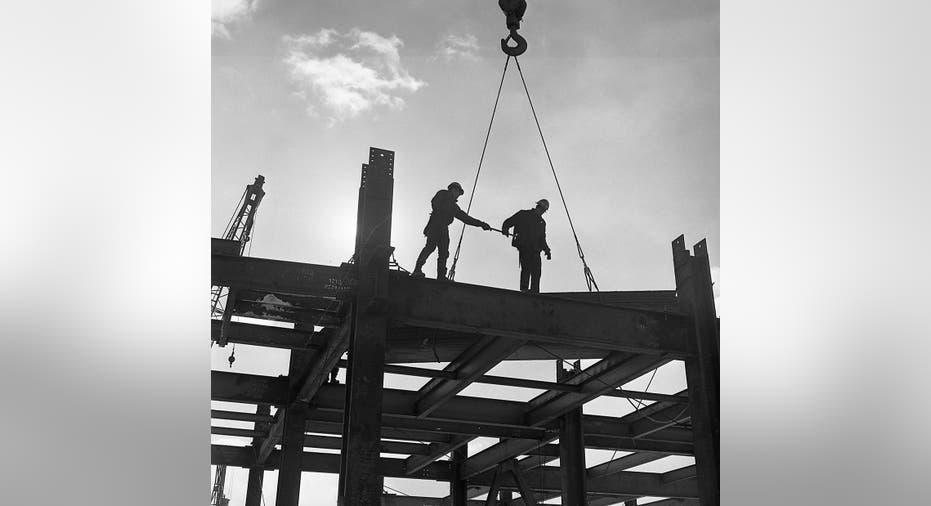Downfall: Defunct steelmaker's global HQ to be imploded
This May 8, 2019, photo shows Martin Tower in Bethlehem, Pa. The 21-story building, the former global headquarters of defunct steelmaker Bethlehem Steel Corp., is set to be imploded on May 19, 2019. (AP Photo/Michael Rubinkam)
Hank Barnette rode an elevator to the top floor of Martin Tower, walked to the empty spot where his office once stood and took in the expansive view, which he'd been too busy to fully appreciate when he was running America's second-largest steel company.
Barnette was there to say goodbye to the cross-shaped, steel-skinned former world headquarters of Bethlehem Steel Corp. A showpiece when it opened in 1972, Martin Tower stood vacant for a dozen years after the steelmaker went out of business.
On Sunday, it's scheduled to be imploded.
"I'm very sad it's going down," said Barnette, Bethlehem Steel's chairman and chief executive from 1992 to 2000, "but I understand why."
Martin Tower's current owners spent years trying to redevelop the 332-foot (101-meter) structure — the tallest in a heavily populated region that includes the cities of Allentown, Bethlehem and Easton — but ultimately concluded it made more economic sense to knock it down and start over. Plans call for a $200 million development with medical offices, retail stores, a restaurant, a convenience store, a hotel and 528 apartments.
Bethlehem Steel, an industrial titan that armed the U.S. military, forged steel for the Golden Gate Bridge and helped shape skylines across the country, was still riding high when corporate executives decided to build a gleaming office tower less than 2 miles (3 kilometers) from the company's flagship mill.
Built over three years, Martin Tower was constructed of — what else? — steel, lots and lots of steel, from the girders and exterior cladding to movable walls, furniture and even window blinds. It was a dazzling display of the company's manufacturing prowess.
Bethlehem Steel was "at its zenith in terms of success and prestige," according to a corporate history attached to the building's 2010 listing on the National Register of Historic Places. Martin Tower, it said, "served to express and commemorate Bethlehem Steel's sense of itself as important to the national economy."
The building had expensive artwork and fine furniture, and top managers took their meals on silver. But the good times wouldn't last. Not long after Martin Tower opened, the U.S. steel industry entered a severe, prolonged recession. Bethlehem Steel failed to innovate and modernize in the face of foreign competition, weakening demand and rising labor costs. The company, which employed more than 120,000 people when Martin Tower opened, declared bankruptcy in 2001 and closed for good two years later.
As Bethlehem Steel went down the tubes, some people looked at Martin Tower and its distinctive cruciform shape — designed that way to maximize the number of corner offices — and saw 21 stories of bloat, hubris and shortsightedness. "It was a symbol of corporate greed in the eyes of many people," said Bethlehem Mayor Robert Donchez.
Historian Mike Piersa takes a more sympathetic view of Martin Tower, noting that Bethlehem Steel had outgrown its existing corporate offices and simply needed the space. The steelmaker was enormously profitable at the time, and the building's opulence is what you'd expect to see at the headquarters of a major corporation, he said.
From the standpoint of company leaders, "if you have an optimistic viewpoint, then it's not that big of a deal to be putting up a skyscraper like that," said Piersa, who works at the National Museum of Industrial History, located on the site of the shuttered mill.
The looming demise of Martin Tower has generated some controversy, with preservationists lamenting the loss and hundreds signing a petition that calls Martin Tower a "local treasure" that should be saved.
But the mayor said most residents have a stronger emotional attachment to the 20-story Bethlehem Steel blast furnaces that have distinguished the local skyline for more than 100 years, and to other historic buildings at the shuttered plant. A casino that opened there in 2009 transformed what was then the nation's largest abandoned industrial complex into an $800 million destination that incorporates the site's steelmaking past.
"All hell would break loose" if the blast furnaces — which went cold in 1995 — ever came down, Donchez said. As for Martin Tower, he said, "we need to move on."
By the time Barnette, the ex-CEO, visited last week, the building was a shell of concrete and steel. Crews had removed just about everything else to limit the debris and dust that'll be generated by Sunday's implosion.
Explosives will take out the building's structural support columns — which have been cut in strategic places — and gravity will do the rest, according to Jim Santoro at Controlled Demolition Inc.
The steel will be recycled.

